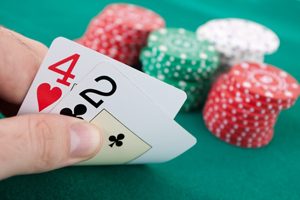
Just as implied odds can become inverse implied odds, so can bluff equity become inverse bluff equity. Imagine that we are playing a hand with a nut blocker, planning a strong bet if a flush draw comes into play, because we think that the opponent will never play a draw with what he has now. If he decides to play a flush draw with what he has and in a different way than we expected, we would be at risk of losing more money than we had planned if the flush really does come up. Using bluff equity against a player who slowplays or structures his range differently than we think can backfire on us. In addition to bluff and reverse bluff equity, there is another important aspect that most people misunderstand.
A question to think about: what hand do you want to represent to people when you bluff? Most of the time, people intuitively answer: strong. But this is a definite mistake.
If we think about it, your opponent cares little whether your hand is strong or not, what he cares about is whether his hand can beat yours. So if he has a weak hand, you don't need to represent a strong hand, you just need to show that you have a slightly stronger hand than his.
This is a common mistake among poker players who think about bluffing. They concentrate on bluffing in places where they can represent that they have a colour or a straight, sets or overpairs and other similar hands. But in reality, all these hands have a very low frequency. You really don't get them as often as you would like. So why try so hard to show that you have them?
Instead, it is better to show that you have a medium pocket pair or a top pair with a low kicker. You should bluff more often with check/check/bet, check/bet/bet or bet/check/bet, which in itself shows weaker hands. You get these hands quite often, so you can bluff more often. You won't win big pots this way, but the pots you do win will contribute to the results in the long run. Winning 10bb in 100 hands obviously increases the winrate.
The following bluffing principle can be accepted as a higher level principle, as it is highly dependent on psychology. Let's assume that the opponent is quite intelligent and actively thinking about your ranges. You are in a situation where all your hands will have at least some showdown value. Eventually, your opponent will conclude that you will take the least risky path (which is usually a good assumption). So, when he knows that you will probably check more often and only occasionally, by sheer luck, win without risking anything, his opponent will assume that it is not a bluff. So he will minimise the frequency of your bluff. And this is where you have to bluff.
In general, this principle would be: in situations where your opponent thinks you don't need to bluff, you should bluff. Of course, this principle only applies if the opponent is thinking about such things, or if the venue is far enough away from the centre for him to consciously think about the possibility of a bluff. If he is not thinking about your psychology, or is simply distracted, then this principle can be thrown overboard.
As you can see, bluffing is much more than just representing a strong hand, there are many subtler aspects.





